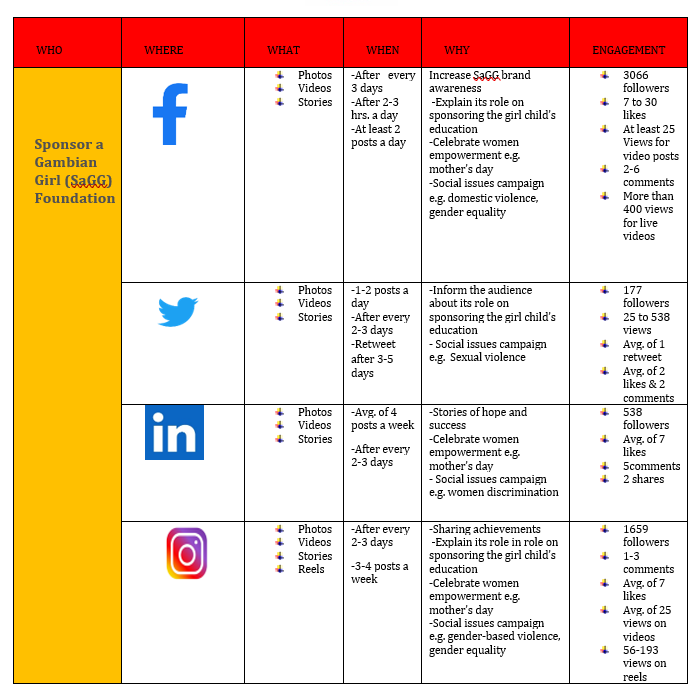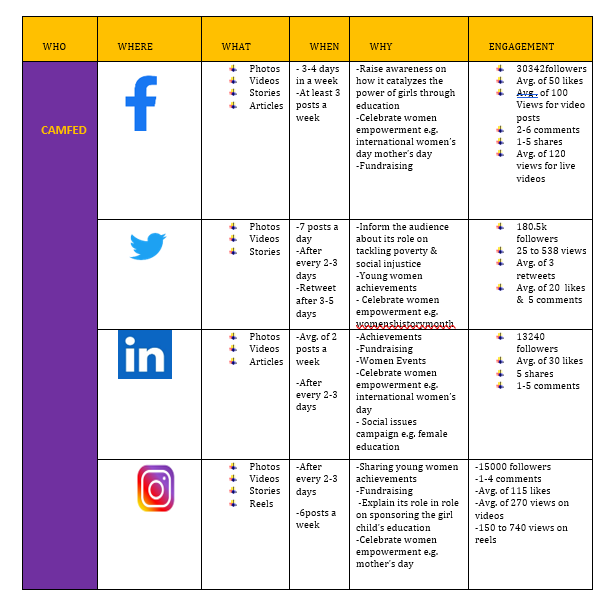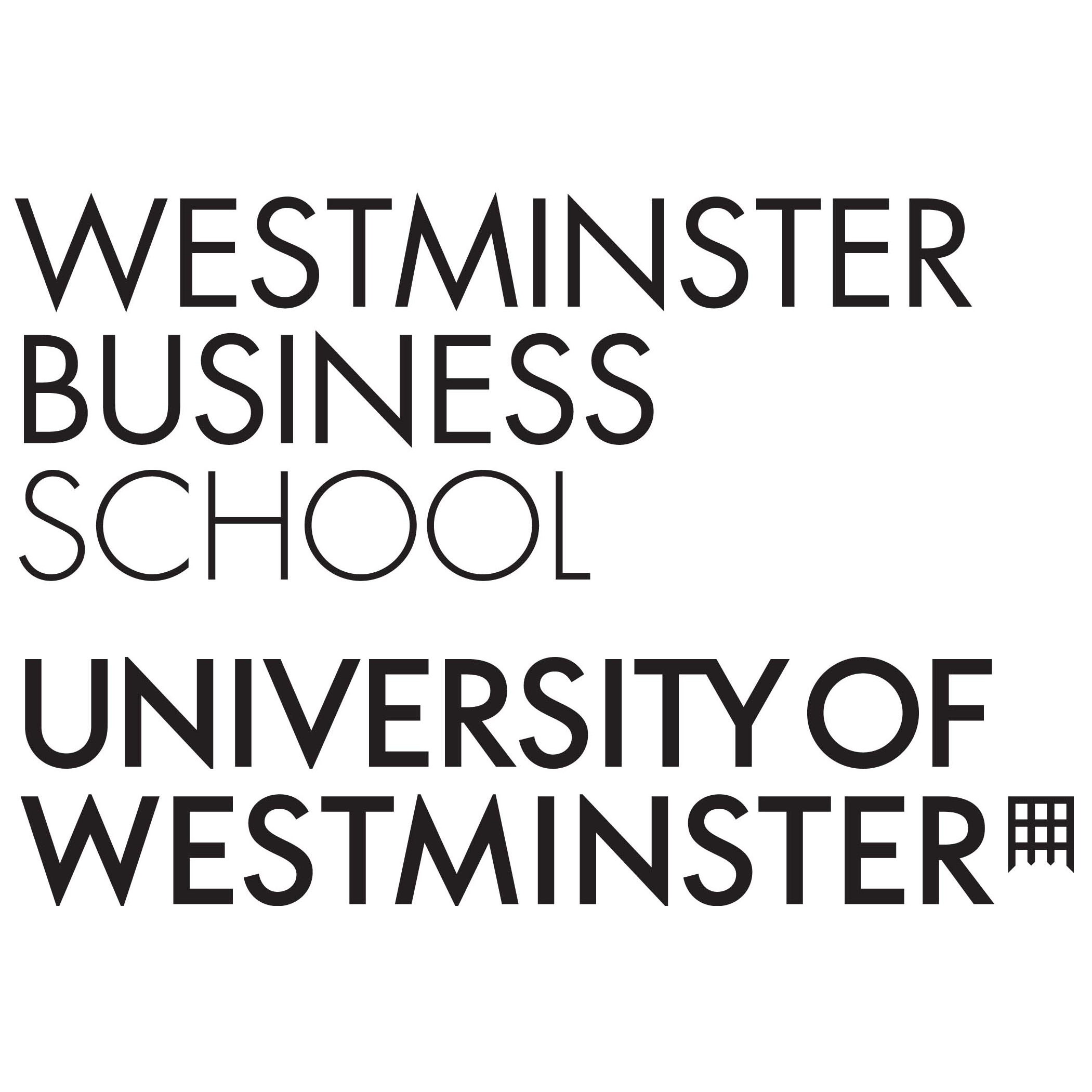The role of social media listening cannot be overemphasized in today’s competitive business environment. Many companies are conducting social media listening by auditing their online brand presence to improve their social media performance. Powell (20160) defines social media listening as the tracking of a company’s business presence on various social media platforms to pulling insights from them and make better decisions. Social media listening or auditing tools have numerous benefits including track competitors, finding consumers’ pain points and discover new sales leads (Tuten, and Solomon, 2020).
Sponsor a Gambian Girl (SaGG) Foundation is one of the non-profit organizations which seeks to sustainably empower girls and women in The Gambia through education. Statistics reveal that 30% of girls in Gambia are married off before they attain 18years since many of them lack financial support to attend school (SaGG, 2022). Unfortunately, the emergence of the coronavirus pandemic has negatively affected SaGG to sponsor many girls due to financial constraints. As a result, there is a need to conduct a thorough social media auditing to focus its intervention on connecting schoolgirls in The Gambia with potential sponsors in the UK, Germany, and other countries. Social media listening will help SaGG to develop a solid understanding of how potential customers, competitors and sponsors think about SaGG Foundation when learning what they say on social channels (Batrinca, and Treleaven, 2015).
SaGG Foundation Social Media Audit
SaGG Foundation needs an effective social media audit to monitor online conversations about the brand on its social media channels. The audit will help SaGG to engage with potential sponsors on social media who are interested in funding the girls and women empowerment in Gambia to eradicate poverty.


Competitor’s Audit
Campaign for Female Education commonly known as CAMFED is an international non-profit organization whose mission is to eliminate poverty in Africa by educating girls and empowering young women in Ghana, Zambia, Zimbabwe, Malawi and Tanzania. CAMFED sponsor girls’ education, support them to prosper, and unlock their power to lead.

By conducting the social media audit for CAMFED, SaGG Foundation is able to audit CAMFED’s social media assets, observe their content strategy, and interactions between customers (Claro et al., 2020). The competitor’s audit revealed areas of improvement SaGG Foundation needs to work on. For instance, SaGG needs to increase its brand awareness in all social platforms to increase its followers. The charity foundation has relatively lower number of followers and posts compared to its competitor, CAMFED. For instance, SaGG has 3066 followers on Facebook compared to CAMFED’s 30,342 followers. On Twitter, SaGG has less than 200 followers while CAMFED has more than 180, 000 followers. Such a huge difference gives CAMFED more brand visibility and competitive advantage to raise funds from sponsors and donors. By far, SaGG’s user engagement is way below compared to CAMFED’s. For instance, CAMFED has an average likes of 155 on Instagram compared to SaGG’s 7 likes. CAMFED uses hashtags such as #CAMFEDsisterhood to increase user engagement. Therefore, the social media audit will help SaGG refocus on its social media marketing strategies to attain its business goals, mission and objectives (Claro et al., 2020). However, SaGG Foundation performs better than other social media competitors such as iAfrica foundation and Girl-Rising Global Education Fund. iAfrica foundation is a UK-based charity organization that uses technology to develop livelihoods improve education and increase awareness of climate change among African children. On the other hand, Girl-Rising Global Education Fund aims at advancing gender equality and education quality for boys and girls living in poverty. These two charity organizations don’t have a social media presence as they don’t have Facebook or Twitter accounts. Analysing competitors is an effective brand audit strategy that guides a brand to plan and implement its social media marketing plan (Tuten and Salomon, 2020). Companies should asses their presence on social media and those of their competitors to see what consumers say about their brand and that of competitor’s. Analysing competitors is an effective brand audit strategy that guides a brand to plan and implement its social media marketing plan (Tuten and Salomon, 2020). Companies should asses their presence on social media and those of its competitors to see what consumer say about their brand and that of competitor’s.
Industry Social Trends and Consumers/Donors Social Media Habits
The interests and buying patterns of consumers change constantly. Therefore, it is important to analyse industry social trends and change in consumers’ social media and content habits. Analysing such elements will help SaGG to understand why consumers choose its brand instead of competitor’s or vice versa.
SaGG’s consumer persona are women aged 21 to 40 years, educated to university level and have mid-career job levels. The pain points of its target audience are discrimination, violence, abuse, gender biases and stereotypes. The primary audience is motivated to sseeing women and girls overcoming challenges in male dominated sectors. Such an audience has high potential to sponsor girls and young women to get quality education.



Recommendations
Based on the collected data, SaGG needs to improve on its social media presence and content. The charity foundation needs to increase brand awareness to attract more men followers. This will improve the organization’s numbers of potential sponsors. Moreover, the organization should increase its social reach to other countries apart from the US, Gambia and the UK. It can also focus on areas such as Canada, Africa, Asia and others where its competitors market their brand.
SaGG should create an effective social media strategy and content, that would direct traffic to its website for site visitors. The organization can put more engaging content on its social platforms to increase relevant followers, engagement, and mention. For instance, SaGG should post more stories on how it educated and empowered girls in Gambia. It can also share animated photos or videos with real images of girls when sharing their testimonies. Unlike its competitors such as CAMFED, SaGG rarely posts fundraising campaign content. Thus, it should put more focus on sharing fundraising campaign content to attain their financial goals.
SaGG need to implement the ‘produce and promote’ strategies of the 4Ps of global Content marketing cycle as shown below.

Promote: SaGG should implement a market-driven content distribution plan with paid and social media strategies to reach wide target audience in broad geographical areas. The foundation should post its content with optimum frequency in targeted channels.

